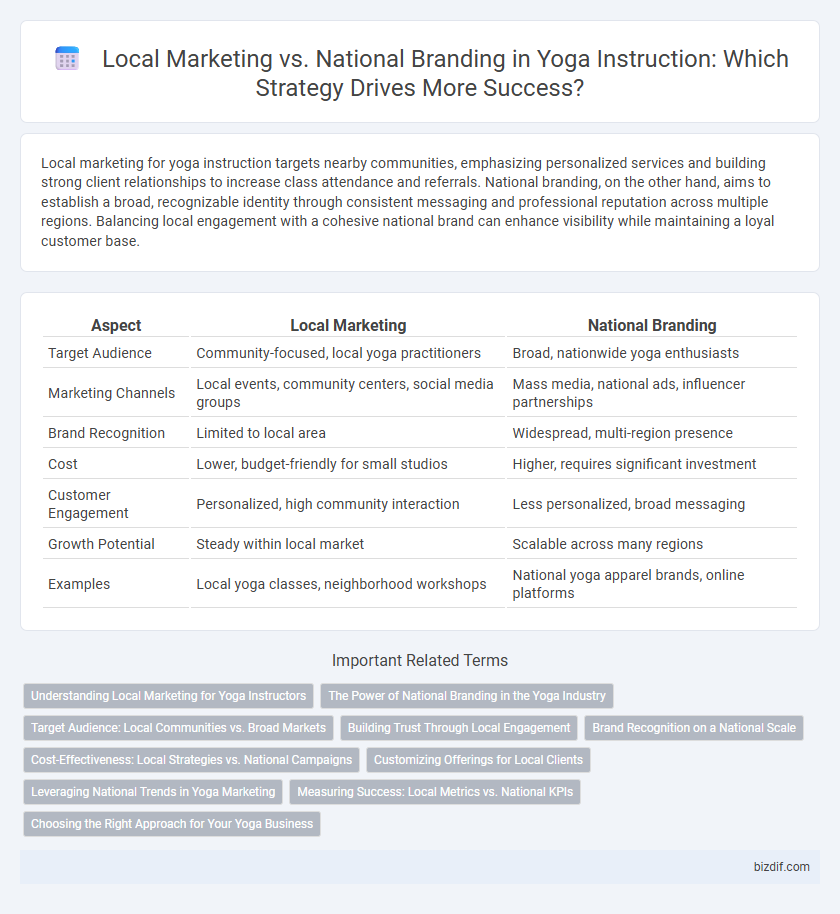Local marketing for yoga instruction targets nearby communities, emphasizing personalized services and building strong client relationships to increase class attendance and referrals. National branding, on the other hand, aims to establish a broad, recognizable identity through consistent messaging and professional reputation across multiple regions. Balancing local engagement with a cohesive national brand can enhance visibility while maintaining a loyal customer base.
Table of Comparison
| Aspect | Local Marketing | National Branding |
|---|---|---|
| Target Audience | Community-focused, local yoga practitioners | Broad, nationwide yoga enthusiasts |
| Marketing Channels | Local events, community centers, social media groups | Mass media, national ads, influencer partnerships |
| Brand Recognition | Limited to local area | Widespread, multi-region presence |
| Cost | Lower, budget-friendly for small studios | Higher, requires significant investment |
| Customer Engagement | Personalized, high community interaction | Less personalized, broad messaging |
| Growth Potential | Steady within local market | Scalable across many regions |
| Examples | Local yoga classes, neighborhood workshops | National yoga apparel brands, online platforms |
Understanding Local Marketing for Yoga Instructors
Yoga instructors benefit from a targeted local marketing strategy that emphasizes community engagement, personalized class offerings, and partnerships with nearby wellness centers. Utilizing location-based SEO, social media groups, and local event sponsorships increases visibility and trust within the neighborhood. Understanding local marketing helps yoga teachers attract consistent client attendance and build a loyal student base.
The Power of National Branding in the Yoga Industry
National branding in the yoga industry establishes a consistent and recognizable identity that attracts a broader clientele, increasing brand trust and loyalty across diverse markets. Prominent yoga brands leverage nationwide campaigns to highlight unique teaching styles, certifications, and wellness philosophies, differentiating themselves from local competitors. This expansive visibility drives higher enrollment in online classes, merchandise sales, and franchise opportunities, boosting overall business growth and sustainability.
Target Audience: Local Communities vs. Broad Markets
Local marketing for yoga instruction targets community-specific needs, offering personalized classes and events that resonate with nearby residents, enhancing engagement and retention. National branding aims at broad markets by promoting a unified yoga philosophy and lifestyle across diverse regions, attracting a wider audience but often sacrificing localized relevance. Balancing local community connection and expansive brand identity optimizes both customer loyalty and scalable growth in the yoga industry.
Building Trust Through Local Engagement
Building trust in yoga instruction requires deep local engagement that resonates with community values and preferences, fostering authentic connections. Local marketing leverages personalized interactions, community events, and targeted outreach to create a loyal client base, which enhances reputation and word-of-mouth referrals. National branding may increase visibility but lacks the intimate trust derived from neighborhood involvement critical for sustained growth in yoga studios.
Brand Recognition on a National Scale
Local marketing strategies for yoga instruction emphasize community engagement and personalized class experiences, fostering strong neighborhood loyalty. National branding prioritizes consistent messaging, scalable content, and leveraging celebrity endorsements or influential yoga figures to boost brand recognition across diverse regions. Achieving brand recognition on a national scale enhances trust and attracts a broader clientele, positioning the yoga brand as a leader in the wellness industry.
Cost-Effectiveness: Local Strategies vs. National Campaigns
Local marketing strategies for yoga instruction deliver higher cost-effectiveness by targeting specific communities with tailored promotions, resulting in better conversion rates and reduced advertising spend compared to broad national campaigns. Utilizing neighborhood events, local partnerships, and geo-targeted social media ads optimizes budget allocation by concentrating efforts where the most responsive audiences reside. National branding campaigns require larger budgets for mass reach but often yield lower immediate ROI due to less personalized engagement and higher competition across diverse markets.
Customizing Offerings for Local Clients
Customizing yoga instruction offerings for local clients enhances engagement by addressing specific community needs, cultural preferences, and regional wellness trends. Local marketing strategies leverage personalized class schedules, targeted promotions, and partnerships with nearby businesses to increase relevance and participation. Tailoring services this way fosters stronger client relationships and sustained local growth, contrasting with the broader appeal of national branding efforts.
Leveraging National Trends in Yoga Marketing
Leveraging national trends in yoga marketing offers studios the opportunity to tap into widely recognized themes such as mindfulness, wellness, and holistic health, creating a strong brand presence that resonates across diverse markets. By incorporating popular practices like virtual yoga sessions and eco-friendly products, instructors can align with broader consumer interests and elevate their brand beyond local confines. This strategy enhances visibility, attracts a larger audience, and positions yoga businesses for scalable growth while maintaining authenticity.
Measuring Success: Local Metrics vs. National KPIs
Measuring success for yoga instruction through local marketing involves tracking community engagement metrics such as class attendance rates, local customer reviews, and regional social media interactions. National branding efforts prioritize broad KPIs including overall brand awareness, website traffic from diverse geographic areas, and large-scale conversion rates. Balancing these distinct metrics is crucial for optimizing both immediate local impact and long-term national growth in the competitive yoga market.
Choosing the Right Approach for Your Yoga Business
Local marketing for yoga businesses emphasizes community engagement through targeted workshops, personalized classes, and partnerships with nearby wellness centers, enhancing client loyalty and word-of-mouth referrals. National branding, by contrast, focuses on developing a consistent online presence, scalable programs, and broad social media campaigns that increase visibility and attract a diverse audience across regions. Selecting the right approach depends on your business goals, resources, and whether personalized connection or widespread recognition drives your growth strategy.
Local marketing vs National branding Infographic

 bizdif.com
bizdif.com